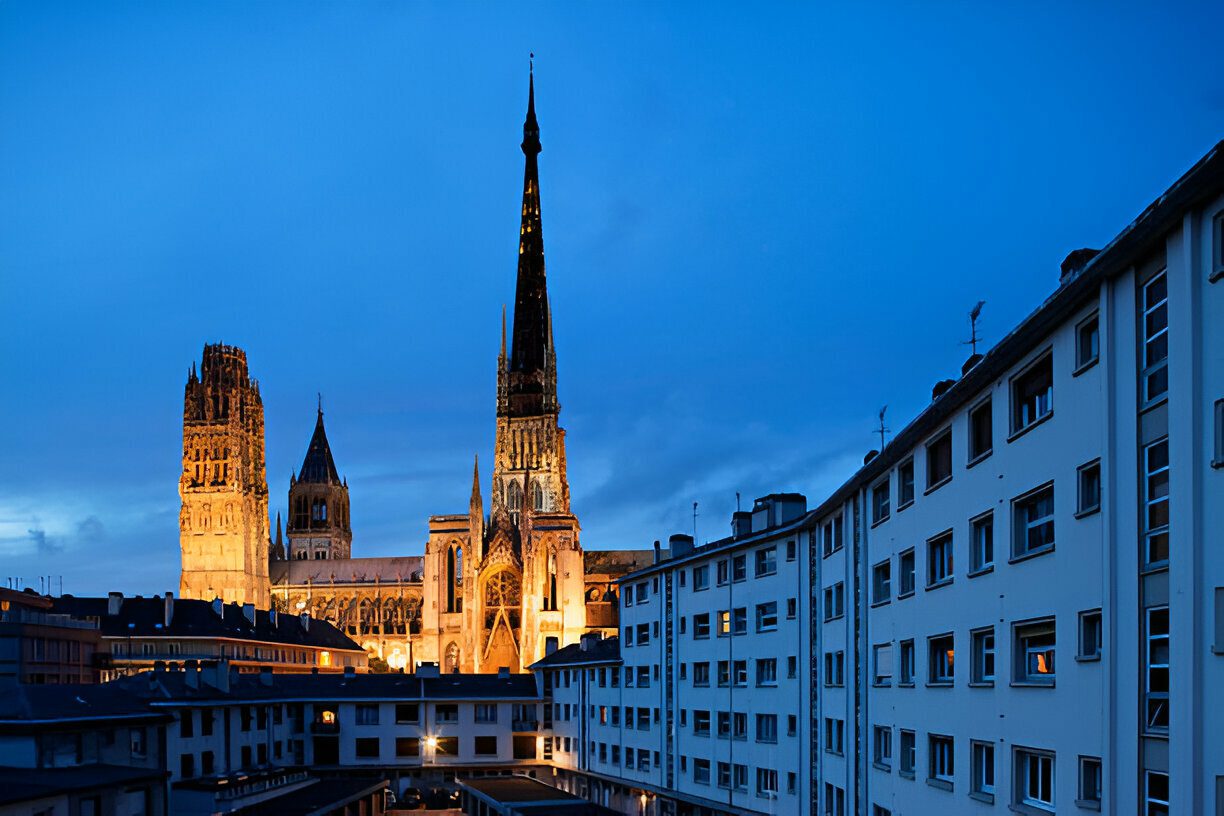France’s renowned Rouen Cathedral has been engulfed in flames, as reported by the city’s mayor, Nicolas Mayer-Rossignol, on his official X (formerly Twitter) account. The mayor noted that the fire had engulfed the spire of the historic building, which dates back to the eleventh century. This monument is famously known for being a favourite subject of French impressionist Claude Monet, who painted it multiple times.
“The origin of the blaze is still unknown,” said the mayor, adding that firefighters have been mobilized.
Ras-le-bol de voir nos églises partir en flammes ! Ici la cathédrale Notre-Dame de #Rouen ce matin.
Accidents ou malveillance, il y a un certain engouement à faire disparaître nos lieux de culte !
Un petit sourire monsieur #Macron ? pic.twitter.com/WXsaPOIBhi
— 🇨🇵 Tony Leprêtre 🇨🇵 (@LepretreTony) July 11, 2024
Images shared on social media depict flames spewing from near the top of the building. According to French media, restoration work has been ongoing at the cathedral since 2015.
The Gothic Notre-Dame de Rouen is notable for having the tallest church spire in France, which rises over 150 meters above the ground.
Local authorities confirmed that the cathedral has been evacuated, and a security cordon has been established around the area. At present, the extent of the damage to the structure remains unclear.
Knowledge Bytes About Rouen Cathedral
Historic Significance: Rouen Cathedral, officially known as Cathédrale Notre-Dame de Rouen, is a prime example of Gothic architecture. It has stood as a significant religious and cultural landmark since its initial construction in the eleventh century.
Architectural Features: The cathedral is renowned for its impressive Gothic style, including intricate stone carvings and stunning stained glass windows. Its façade is particularly noteworthy, displaying a wealth of detailed sculptures that depict biblical scenes and figures.
Claude Monet’s Inspiration: The cathedral gained additional fame through the works of Claude Monet. The French impressionist artist painted a series of over 30 canvases, capturing the cathedral at different times of the day and in various weather conditions. These paintings are celebrated for their exploration of light and atmosphere.
Tallest Spire in France: Rouen Cathedral boasts the tallest church spire in France, reaching a height of over 150 meters (approximately 492 feet). This spire was added in the 19th century, replacing an earlier wooden one that was destroyed by lightning.
Restoration Efforts: Ongoing restoration work has been a significant aspect of the cathedral’s recent history. Efforts to preserve and restore its structure have been underway since 2015, aiming to maintain the integrity and beauty of this historic monument.
Cultural and Religious Role: As an active place of worship, the cathedral continues to hold regular religious services and events. It also attracts numerous visitors and pilgrims each year, drawn by its historical, architectural, and artistic significance.
Surviving World War II: The cathedral endured significant damage during World War II, particularly from bombing raids. However, extensive restoration efforts have since returned it to its former glory, preserving its status as a historical treasure.
The Goths: History, Christianity, and Demise
Historical Background: The Goths were a Germanic people who played a crucial role in the history of Europe during the late Roman Empire. They are divided into two main groups: the Visigoths and the Ostrogoths.
- Visigoths: Initially settled in the region of modern-day Romania and Hungary. They are known for their significant role in the Sack of Rome in 410 AD under the leadership of King Alaric I. Eventually, they established a kingdom in what is now Spain and southwestern France.
- Ostrogoths: Originated further east and north. They established a kingdom in Italy under the leadership of Theodoric the Great in the late 5th century.
Migration and Conflicts: The Goths were part of the larger movement of Germanic tribes that migrated across Europe, often coming into conflict with the Roman Empire. Their migrations were partly driven by the pressures of the Huns from the east. The Gothic Wars, a series of conflicts between the Goths and the Romans, were pivotal in the eventual decline of the Western Roman Empire.
Christian Ideologies: The Goths were among the first Germanic peoples to convert to Christianity, largely through the efforts of Ulfilas, a missionary who translated the Bible into the Gothic language. However, the form of Christianity they adopted was Arianism, which differed from the Nicene Christianity practiced by the Romans.
- Arianism: This doctrine, considered heretical by mainstream Christianity, held that Christ was distinct from and subordinate to God the Father. This theological difference caused tension between the Gothic rulers and their Roman subjects, who adhered to Nicene Christianity.
Integration and Influence: Despite religious differences, the Goths established significant kingdoms within the former Roman territories. The Visigothic Kingdom in Spain and the Ostrogothic Kingdom in Italy were notable for their efforts to maintain Roman administrative systems and culture. The Goths contributed to the preservation and transmission of Roman laws and traditions during a time of widespread turmoil.
Demise: The demise of the Gothic kingdoms was influenced by several factors:
- Visigoths: Their kingdom in Spain was eventually overrun by the Moors in the early 8th century. The Battle of Guadalete in 711 AD marked a decisive defeat for the Visigothic king, Roderic, leading to the rapid Muslim conquest of the Iberian Peninsula.
- Ostrogoths: The Ostrogothic Kingdom in Italy faced continuous pressure from the Eastern Roman (Byzantine) Empire. The Gothic War (535-554 AD), initiated by Emperor Justinian I, aimed to reclaim Italy for the empire. The prolonged conflict weakened the Ostrogoths, and by 554 AD, the Byzantine Empire had largely succeeded in retaking Italy.
Legacy: Despite their eventual demise, the Goths left a lasting legacy in European history. Their interactions with the Roman Empire, their role in the migration period, and their contributions to the early medieval European cultural and political landscape remain subjects of significant historical interest. The Gothic identity, while eventually absorbed into the broader fabric of European society, played a crucial role in the transformation of the Roman world into medieval Europe.
















